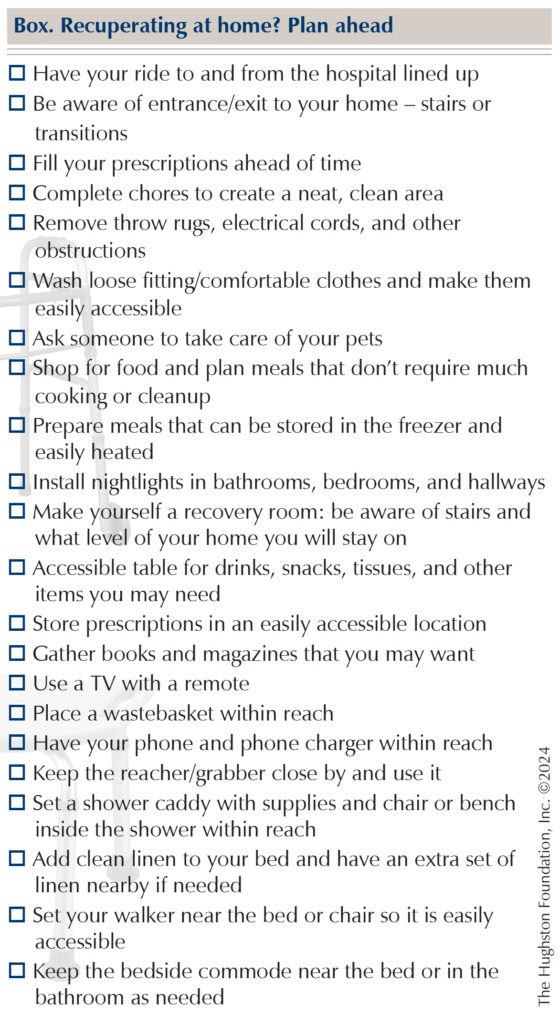Contributing physicians in this story

 Should you have outpatient surgery?
Should you have outpatient surgery?
Arthritis and rheumatic conditions are leading causes of disability among adults in the US. More than 30 million Americans suffer from osteoarthritis, a painful condition that causes the cushioning cartilage between the bones to wear away. As the population ages, researchers expect the number of people who need treatment for knee and hip arthritis pain and disability to skyrocket.
Joint arthroplasty (replacement) is the surgical treatment option designed to relieve pain when nonoperative options have failed (Fig. 1). In the past, patients who had hip and knee problems would undergo complicated surgical procedures that made them immobile for months and required a lengthy recovery process. Medical device manufacturers have improved the surgical instruments and implants over the years, while orthopaedic surgeons have refined their skills, techniques, and surgical approaches. These advancements have come together, so now surgeons can offer some patients the opportunity to have their joint replaced and to go home on the same day.
What is outpatient arthroplasty?
Outpatient total joint arthroplasty is a surgical procedure to replace a damaged or worn-out joint, such as a hip or knee, with an artificial joint. The difference between outpatient and a traditional inpatient joint replacement is that an outpatient procedure allows the patient to return home on the same day of the surgery, whereas an inpatient procedure requires the patient to stay in the hospital overnight or for several days.
The procedure is typically the same for inpatient and outpatient surgery. The surgery often takes a few hours to complete, and then the surgical recovery staff monitors the patient for a short period in a recovery area before discharging the patient home. Surgeons often perform this type of surgery in specialized surgical centers or outpatient clinics, rather than a hospital.
When considering outpatient surgery, your surgeon’s goals are to return you to maximum joint function with minimum risks. Therefore, the surgical approach the surgeon uses is to gain enough visual exposure to complete the surgery while minimizing the effects to the surrounding tissues. For example, some surgeons prefer the posterior approach and using the Mako SmartRoboticsTM surgical system (Figs. 2 & 3). First, the medical team takes a CT scan of your hip, which provides a 3D virtual model of your joint. They use the model to precisely evaluate your joint for disease severity, joint alignment, and determine the size, placement, and alignment of your hip implant. During surgery, the doctor uses the Mako robotic arm to remove the arthritic bone and cartilage from the hip as preplanned.
What are the advantages of the surgery?
The most significant advantage of outpatient total joint surgery stands out—the patient goes home on the same day of the surgery. This means you can recover in the comfort of your own home rather than spending several days in the hospital. Since you go home a short time after surgery, you have a lower risk of hospital-acquired infection. Often, the surgery can be less expensive than traditional inpatient joint replacement since the hospital stay is shorter and you use less hospital resources. However, patients must carefully follow their postoperative care plan to ensure a successful outcome.
Are you a good candidate?
Surgeons offer outpatient joint replacement surgery to patients who are healthy enough to undergo surgery and who have a support system at home to help with recovery. First, you cannot proceed to surgery until you receive clearances from your other physicians, such as your primary care doctor. You may also see your dentist, cardiologist, pulmonologist, or any other specialist to give the “OK” that you are healthy enough to proceed with surgery. Clearances are important for lowering the risk of complications during and after surgery. Your physicians can schedule x-rays, bloodwork, and other tests related to your health. The results will be shared with the surgeon prior to surgery.
Who may need to go the traditional route?
Not all patients are candidates for outpatient joint replacement surgery. Discuss the advantages and disadvantages of outpatient joint replacement surgery with your surgeon to determine if the option best fits your individual needs and circumstances. Patients who have certain medical conditions or those who require procedures that are more complex may require an overnight hospital stay. Patients who may require significant pain control or lack adequate support at home may need to stay in the hospital for a longer period.
 Preparing your home
Preparing your home
Since you are going to recuperate at home, you need to do some preplanning. For example, make yourself a recovery room/area. Please see the checklist of suggestions below (Box). When getting ready for surgery, think about the safety of your home, especially since you may be moving around with a walker for a time. Remove items that block your path to the bathroom and kitchen, or any other rooms that you might use. Remove throw rugs, electrical cords, and other obstructions from walkways. Install nightlights in bathrooms, bedrooms, and hallways. You want your return home to be as easy as possible for you and your caregiver.
Home equipment
Before your surgery, your surgeon can recommend specific adaptive equipment to help when you return home. For example, if you have hip or knee replacement, your doctor may recommend a 2-wheeled walker so you can safely move and a 3-in-1 commode to place on top of the toilet or at bedside. You will not be able to submerge your incision for some time, so the commode seat, a bench, or a shower chair can be helpful while showering. Also, some facilities provide a total joint kit that contains useful tools for home use. The kit can include items such as a reacher, sock-aid, long-handled shoehorn, or a long-handled bath sponge. If the facility does not provide these items, you may want to purchase them.
Once you have the equipment that your doctor recommends, be sure to call the doctor’s office or let your surgeon know at your preoperative visit. Without the home equipment, your doctor may recommend that you stay in the hospital longer.
Going home
Often, patients stay in the recovery area several hours before going home. During that time, your medical team may give you some goals to achieve before you can leave recovery. Most patients go home after surgery; however, some patients are discharged to an impatient rehabilitation center if you need more assistance.
Before you head home, your medical staff will go over instructions that are relevant to your medical care. You will have a list of some do and don’ts, and some symptoms to watch out for during your recovery. The staff will also explain your medications and tell you when to come back to see your surgeon. If you have home health or physical therapy as part of your treatment, they will provide information about when these services will begin. If you have any questions or concerns, you can call your surgeon’s office. While you recuperate in the comfort of your home, be sure to follow the postoperative care plan to ensure a successful outcome.
Author: Justin Fernicola, MD | Columbus, Georgia
Last edited on September 13, 2024